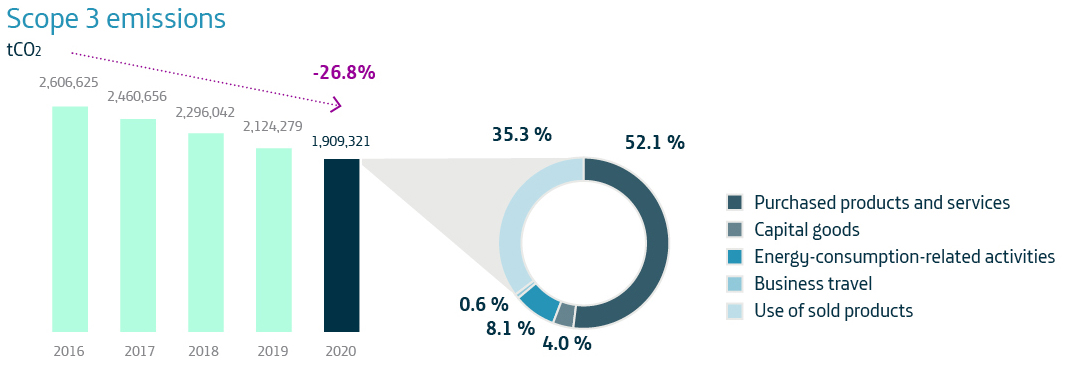Lourdes Tejedor / @madrid2day
Telefónica’s example for the value chain
 31% of the mobile connections and 36% of the sector’s revenue -more than a third of the mobile industry- have credibly committed to net zero emissions by 2050 or earlier through the UN Race to Zero campaign. Operators with science-based carbon reduction targets account for 50% of the connections and 65% of the industry’s global revenue. In this regard, it is at the forefront (Breakthrough Sector) in line with the Climate Action Pathways, the roadmaps for achieving the Paris Agreement in all sectors.
31% of the mobile connections and 36% of the sector’s revenue -more than a third of the mobile industry- have credibly committed to net zero emissions by 2050 or earlier through the UN Race to Zero campaign. Operators with science-based carbon reduction targets account for 50% of the connections and 65% of the industry’s global revenue. In this regard, it is at the forefront (Breakthrough Sector) in line with the Climate Action Pathways, the roadmaps for achieving the Paris Agreement in all sectors.
These are some of the findings of the GSMA Association’s “Mobile Net Zero – State of the Industry on Climate Action 2021” report, the first publication on how the mobile industry is addressing its goal of net-zero emissions by 2050. The analysis also includes a compendium of best practices from companies such asTelefónica, which shares how it is reducing emissions throughout the value chain, particularly in its suppliers.
The sector’s energy efficiency is improving every day. In 5G networks it requires a 90% reduction in energy use to transfer each bit of data, while its role in decarbonising the entire economy is also growing: a research project with the Carbon Trust has found that although the mobile industry is currently responsible for around 0.4% of global carbon emissions, it enables carbon reductions in other sectors that are 10 times greater, equivalent to around 4% of global emissions.
The industry is part of the solution to climate change as it is capable of reducing CO2 emissions by 10 times the amount it emits
Telefónica success story
Telefónica is committed to having net-zero emissions by 2025 in its main markets, taking into account Scopes 1+2; and to also include Latin America and Scope 3 (its value chain) by 2040.
During the last year, Telefónica has taken the challenge of tackling climate change by reducing emissions within its whole value chain. Having set an ambitious goal of reducing its value chain carbon emissions up to 39% in 2025 and become net-zero in 2040, the telco is proactively influencing its suppliers’ emissions management (goals aligned with 1.5ºC scenario of the Paris Agreement).
In 2020, these emissions dropped 26,8% compared to 2016 (base year), totalling 1.909.321 tCO2eq. It has been identified that Telefónica’s main Scope 3 emissions originate from supply chain purchases (both “Good and services” and “Capital goods”) (56%) and the use of products and services provided to its clients (35%).

Suppliers committed to reducing their footprint
Telefónica’s ‘Supplier Engagement Program’ and adhesion to the ‘1.5 Supply Chain Leaders Program’ constitute the company’s most recent and impactful initiatives towards reaching these goals.
During the last 2 years Telefónica has worked closely with its most relevant suppliers in its Supplier Engagement Program in order to set more ambitious reduction targets while learning and set a space for co-creation. Each supplier could define targets related to managing their footprint on diverse topics such as Energy, Emissions, Transportation, Product (Life Cycle Analysis), Carbon Pricing and “100” initiatives (using renewable energy as indicated by the RE100 initiative or switching to electrical vehicles, following the EV100). In addition, Telefónica continued providing support to suppliers who had already committed to emissions reductions in order reach their goals and started new joint projects.
Similarly, in 2020 Telefónica created a sectoral working group within the JAC (Joint Audit Cooperation) initiative to drive climate action in the Telco supply chain. As a result, 26 strategic suppliers have been assessed on their climate maturity and several workstreams have been created in order to increase their level of ambition. In addition, a couple of trainings in collaboration with CDP and GSMA have been provided to the most relevant suppliers and one specific training has been delivered for Chinese companies.
More eco-design to save energy
Telefónica is also working in reducing emissions from the products and services sold to its customers, mainly from the power consumption of routers and TV set-top boxes. Thus, the company will continue to promote the eco-design of this equipment. Telefonica’s Smart Wifi router have already been improved and demonstrate 30% energy reduction compared to the previous solution for FTTH connection.
Another relevant action in 2020 was to join the ‘1.5°C Supply Chain Leaders’ initiative which advocates the reduction of emissions by small and medium-sized companies that are part of Telefónica’s value chain. This program will enable to strengthen their role in accelerating the decarbonization of the global economy.
These recent efforts have led Telefónica to join CDP’s Supplier Engagement Leaderboard 2020 in order to join forces towards driving the transition to a net-zero emissions society.









